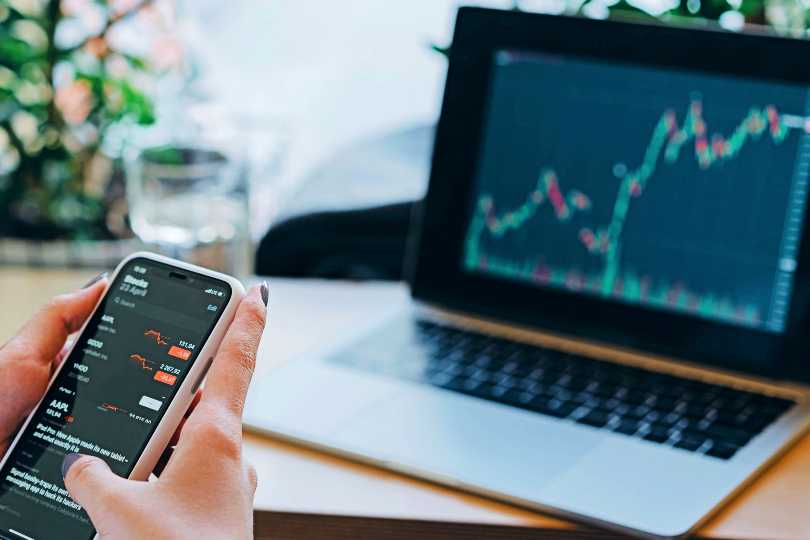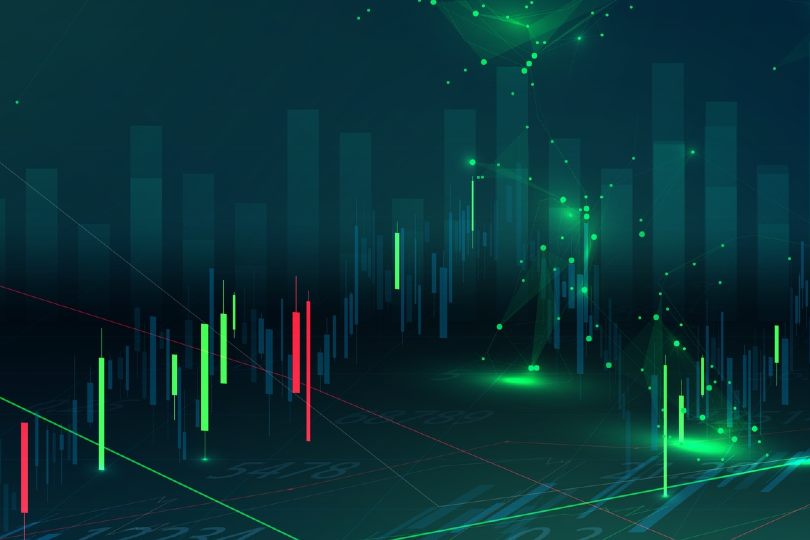What are CFDs?
CFDs, or Contract for Differences, are financial instruments that allow traders to speculate on the price movements of various assets without owning the underlying asset itself.
When trading CFDs, traders enter into an agreement with a CFD broker to exchange the difference in price of an asset from the time the contract is opened to when it is closed. This means that traders can profit from both rising and falling markets, as they can take either a long (buy) or short (sell) position.
My key takeaways
- CFD trading uses the difference between two specific price points to calculate the returns or loss of a position.
- CFDs use leverage and are a particularly advanced way to trade.
- You never own the underlying asset when trading CFDs.
How do CFDs work?
CFDs are a method of trading financial markets such as stocks, stock indices, forex, and currency pairs.
It works by partnering CFD traders who want to speculate on the price movement of an asset with a broker, who provides the contract.
A contract is then opened, binding the trader and broker to either buy or sell a predetermined number of units of an asset once it reaches a certain price point.
Using the price at which the contract was opened between the CFD trader and broker – this is based on the price of the underlying asset – their returns or losses depend on the difference between the opening price of the trade and the price at which it is closed.
Essentially, CFDs are tradable contracts between a client and the broker, who are exchanging the difference in the initial price of the trade and its value when the trade is closed.
As such, when you open a “buy” trade, you speculate that the price of an asset will rise. Your returns or losses are correlated to the difference in price between the opening and closing values of the asset – the asset’s price must increase for the buy position to profit.
Inversely, sell positions involve speculating that an asset’s price will decrease. Losses are still determined by the difference in opening and closing prices, only the price must decrease for you to profit from sell positions.
How much you gain or lose is determined by multiplying your total position size by the difference in price between when you opened and closed the contract.
You never own any of the underlying assets that you trade – you enter a hypothetical agreement to either buy or sell an asset at the price you agreed in the contract with your broker. This is unlike traditional trading and investing, in which you purchase and own assets, such as stocks and shares or fund units.
One of the key features of CFDs is the leverage they offer. Traders are only required to deposit a fraction of the total value of the position, known as the margin, while the broker provides the rest. This allows traders to control larger positions with a smaller initial investment.
However, it’s important to note that while leverage can amplify potential profits, it also amplifies losses, making CFD trading a high-risk endeavor that requires careful consideration and risk management.
CFD Trading Explained
When a trader opens a CFD trade, they are essentially speculating on the direction of the price movement of the underlying asset.
If the trader believes that the price will go up, they buy a long position. If they believe that the price will go down, they buy a short position.
The profit or loss of the trade is determined by the difference between the opening and closing price of the contract.
CFD trading allows traders to use leverage, which means they can control a larger position with a smaller amount of capital. However, this also means that losses can exceed the initial investment.
Buying or selling
The dichotomy that defines CFDs is the option of whether to buy or sell.
This is how traders speculate on the asset – by trying to predict the direction of an asset’s price movements.
As such, buying and selling CFDs represents the direction in which you believe the asset’s price will move.
Buy positions
When using buy positions, you are agreeing to sell an asset in the future, regardless of the price movement.
So, by opening a buy position, you are agreeing to buy units of a specified asset whether the price rises or decreases – this is how losses or gains are made.
As a result, if the price goes up, you are essentially “selling” the asset back to the broker with an increased value, making positive gains.
However, if the price of the asset was to decrease, you would be required to sell the same asset back at a lower price at the end of the trade, making a loss as a result.
Buy positions are also known as “long” positions, or “longing”.
Sell positions
Also known as a “short” position, “short selling”, or “shorting”, sell positions act in the same manner as buy positions but with an inverse effect.
This means you agree to sell an asset at a given price with the promise of buying the same assets back at the end of the trade. The difference – upwards or downwards – is then used to calculate the gains or losses.
So, if the price of an asset decreases below the price at which you opened your sell position, the CFD position would be in profit.
Of course, if the asset increases in price, you would make a loss.
Leveraged trading
You will often be given access to leverage when trading CFDs.
Rather than paying for the entire position upfront, you may use leverage from your broker to increase the size of their position.
This amount is simply “borrowed” for the specific trade and you do not keep the full amount – only the amount by which the position has increased.
Leverage allows you to pay for a fraction of the position size while trading with a greater amount.
Your returns will then be magnified by the leverage you have taken. Any losses will also be magnified, which is why leverage is often considered a double-edged sword.
Leverage is expressed as a ratio in order to indicate the amount by which your position size is increased.
For example, if your account had funds worth £1,000 and you opened a trade using a leverage of 10:1, your position size would be £10,000 as a result.
It’s important to note that if a CFD broker in the UK is regulated by the Financial Conduct Authority (FCA), retail investors are limited to leverage between 2:1 and 30:1. This is to protects non-professional investors from taking on more leverage than they can manage.
Margin trading
When trading with leverage, you may see the term “margin” used. This is the amount of the trade that you are required to use upfront to make a leveraged trade.
For example, the £1,000 in the trade I mentioned above would be the margin for that trade.
The margin is calculated as a percentage or ratio, and displays your level of exposure during a trade.
Negative balance protection
Leveraged positions can result in incurring a loss greater than the value of funds in your account, resulting in a negative balance.
Negative balance protection is a feature used to protect traders from losing more money than what is in their account, even during erratic price movements.
FCA-regulated CFD brokers are required to offer “negative balance protection”.
Negative balance protection automatically liquidates or closes any positions before they cross into a negative balance.
This is useful when trading international CFD markets, since you may not always be able to keep tabs on your trade when considering time differences.
For new CFD traders, or anyone who seeks to limit their risk exposure, this feature could be especially useful.
What assets can you trade using CFDs?
Many brokers in the UK facilitate CFD trading across a range of different assets including:
- Shares
- Indices
- Commodities
- Forex
- Cryptocurrency
CFDs vs futures contracts
The main difference between CFD trading and futures contracts is the temporal aspect of futures. While both rely on speculating potential price movements, either upwards or downwards, futures contracts have a set expiry date from the start.
This is different to CFD contracts, which can be held as long as you wish.
That said, something these two methods of trading have in common is their respective partnerships with leverage. Both CFDs and futures contracts are often traded using leverage in order to increase position sizes.
Another similarity is the fact that you don’t own any of the underlying assets that you are trading and you only receive the gains or incur losses as a result of the price movement, not the asset itself.
Futures can involve the underlying asset, but rarely do in practice.
What are the costs of trading CFDs?
There are various fees and trading costs you may face when trading CFDs.
Brokers’ fees
Each order executed during a CFD trade will often incur a commission fee that goes to the broker. This will vary from broker to broker, and is likely to be charged on both the opening and closing trades of the position.
This cost is normally exclusive to trading CFDs on stocks, and there may also be a financing cost for giving you access to leverage.
If you trade with large positions, this fee could become significant and is worth factoring into your trading strategy.
Spread cost
In trading environments, assets are given different prices besides the market price – the “bid” and “offer” prices. These are both important to understand in order to get a well-rounded view of the fees associated with trading CFDs.
Essentially, the spread is the difference between the price at which you buy an asset and the price at which you sell. This moves with the price of the asset itself and may widen or narrow at any point.
In order to trade the asset, you must pay an initial fee that covers the spread when your position was opened.
This happens every time you open a position, meaning you are likely to be at a small loss automatically.
If the market moves rapidly, either up or down, the spread may be higher.
CFD trading FAQs
Is CFD trading good for beginners?
Are CFDs legal in the UK?
Please note:
The value of your investments (and any income from them) can go down as well as up and you may not get back the full amount you invested. Past performance is not a reliable indicator of future performance. Investments should be considered over the longer term and should fit in with your overall attitude to risk and financial circumstances.
Forex & CFDs are complex products, not suitable for everyone and come with the high risk of losing money rapidly due to leverage. You should consider whether you understand how CFDs work and whether you can afford to take the high risk of losing your money.
Cryptocurrency is not regulated by the UK Financial Conduct Authority and is not subject to protection under the UK Financial Services Compensation Scheme or within the scope of jurisdiction of the UK Financial Ombudsman Service. Investing in cryptocurrency comes with risk and cryptocurrency may gain in value, or lose some or all value. Capital Gains Tax may be applicable to profits from cryptocurrency sales.



